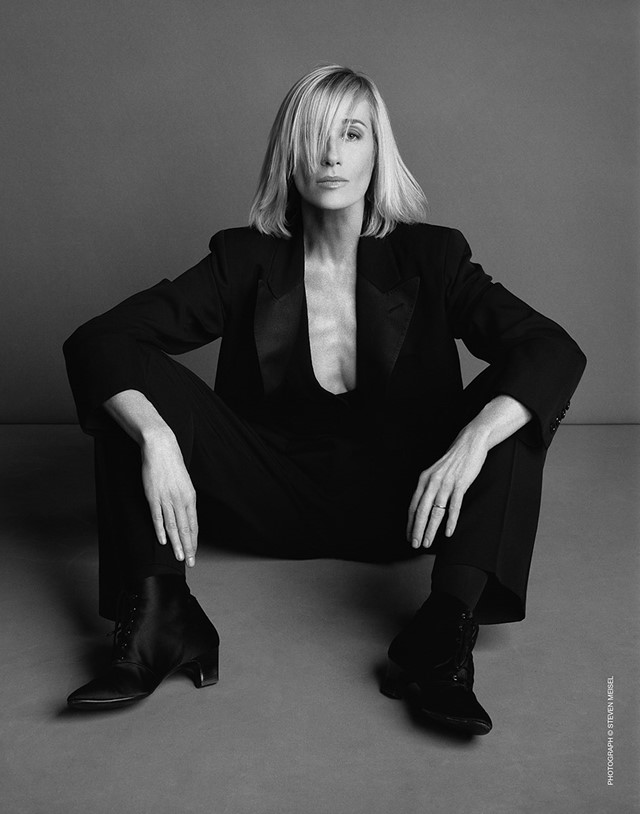Opening today in Paris, Betty Catroux, Yves Saint Laurent: Feminine Singular explores the perennial style and influence of the woman Yves Saint Laurent called his “double”
If Yves Saint Laurent was well known for the glamorous coterie of women he kept in his company – from Paloma Picasso, Victoire Doutreleau and Loulou de la Falaise, to Catherine Deneuve – it was from Betty Catroux, the six-foot-tall shag-haired Brazilian model, that he would become inseparable. “Betty est mon double, ma couplice,” the feted designer once said – “Betty is my double, my partner in crime”.
“For Yves it was love at first sight, physically,” says Catroux, on the occasion of Betty Catroux, Yves Saint Laurent: Feminine Singular, a new exhibition which opens this week at Musée Yves Saint Laurent Paris. “I was androgynous, asexual. It definitely affected him, but our resemblance was not only physical; we were alike morally, mentally, it was something incredible.”
The exhibition will celebrate the pair’s lifelong partnership, collating 50 items of clothing that Saint Laurent gifted to Catroux throughout her life, curated by the house’s current creative director Anthony Vaccarello. The Belgian designer has been similarly charmed by Catroux: for Autumn/Winter 2019, he conjured her spirit on his own runway (towering blonde Swedish model Vilma Sjöberg, in a wide-shouldered wool trench, abbreviated black mini-dress and requisite world-shielding sunglasses, was a worthy doppelgänger); a year prior, he had cast Catroux herself in an Autumn/Winter 2018 campaign, photographed by David Sims.
“She lives and breathes Saint Laurent,” says Vaccarello. “[She has] an allure, a mystery, an almost nefarious aspect, an elusive yet desirable nature, all that underlies the house’s aura, and you understand the magnitude of it when you meet Betty.”

Elusive might well be the word the describe the straight-talking Catroux, who, despite beginning her career modelling as a teenager for Coco Chanel, has proudly shirked the traditional pressures to make her own living. “A big project of mine is never to do any work,” she said in a recent profile in the New York Times. “It’s all my husband. My biggest ambition in life has always been not to lift a finger.” (Her husband is Françoise Catroux, “the uber-rich’s favourite interior designer,” as per Vanity Fair.)
Both Catroux – who moved to Paris as a child with her mother Carmen Saint, a Brazil-born French socialite – and Saint Laurent were denizens of the city’s then-thriving nightlife scene in the 1960s. They met at New Jimmy’s, a Boulevard du Montparnasse outpost of nightclub impresario Régine. “[Yves] asked someone at his table to talk to me because he was shy, and he asked me to wear his collection,” remembers Catroux of the evening. “I laughed at him and refused. He never had someone refusing him anything! So our passion begun, and he never let me go. It’s a fairytale.”
That fairytale would take them from Paris to Morocco, and Marrakech, the ancient city which became Saint Laurent’s spiritual home (he purchased a residence there in the late 1960s; now, an outpost of Musée Yves Saint Laurent has opened close by). “We lived for seduction. Seduction was our goal. To charm, to seduce; it gave us immense pleasure,” Catroux says of their decadent lifestyle, home or away. “As for the rest, it was all about partying, every night. To only do fun things. Be naughty. Drink. Excess. All the things that people don’t do anymore. We lived to have fun.”
It was this cool demeanour which drew Saint Laurent towards her. Where De la Falaise, the other principle woman in the designer’s life, was the epitome of his bejewelled and feathered ‘la bohémienne’, Catroux was icy and androgynous, her long, lean line and masculine clothing the inspiration for the designer’s Le Smoking tuxedo, perhaps his most enduring creation (as for Catroux, the black blazer continues to be her signature look, decades on). “She’s perfect in my clothes,” he said in 1968. “Just what I like. Long, long, long.”
“I’ve always been captivated by what is masculine. Always wore jeans, a man’s jacket ... I don’t feel like a girl or a boy, but more in a seductive position when dressed in boys’ clothes,” Catroux says. “The clothing I prefer? All the tuxedos that I wore mismatched, nude under the jacket with no accessories. I could wear the jacket with a pair of black leather trousers or black denim jeans. It felt like second skin. The proportions, stability, it was all perfect.”
Several of these pieces will feature in Feminine Singular, which explores Catroux’s enduring influence not simply on Saint Laurent the man, but Saint Laurent the house, decades on. In the exhibition itself, Vaccarello – who was given carte blanche over its contents by Madison Cox, president of the Fondation Pierre Bergé/Yves Saint Laurent – casts Catroux not as ‘muse’ (a word she despises) but as an indefinable cultural harbinger, who spurred Saint Laurent to create his greatest work.
“[The exhibition is] a true lesson, not only in allure but also in liberty and in independence,” says Vaccarello. “Nowadays, people are too afraid to be daring; an insidious puritanism is overshadowing everything, so that kind of lesson is more important as ever.
“That being said, do not expect to find in this exhibition a definitive handbook on ‘how to become the perfect Saint Laurent woman’,” he surmises. “Because Betty also has that mysterious side ... that perpetual ambiguity resisting all kinds of definitions.”
Betty Catroux, Yves Saint Laurent: Feminine Singular is on at Musée Yves Saint Laurent Paris until October 11, 2020.
